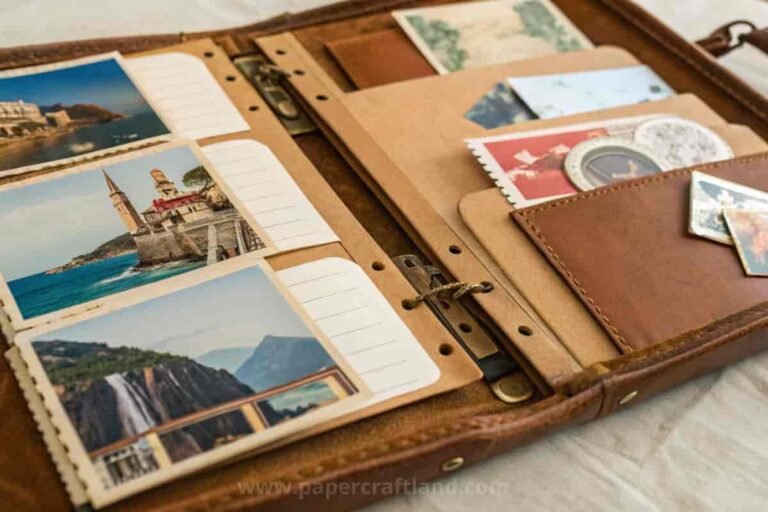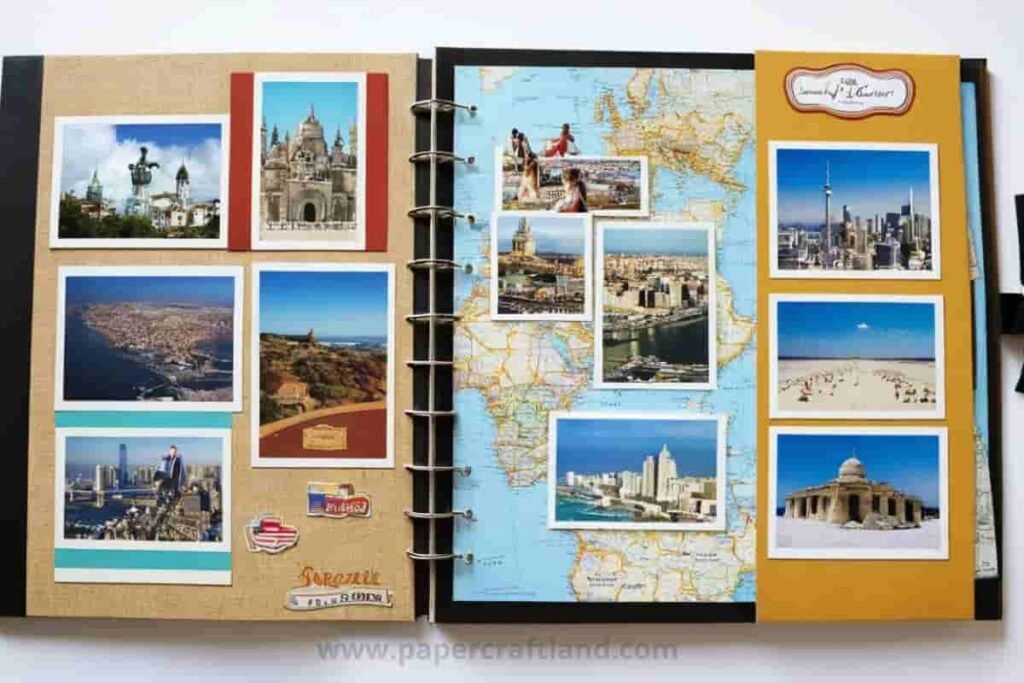Whether you’re a seasoned scrapbooker or new to the craft there’s no better way to preserve your travel memories than with travel scrapbooks.
Every traveler knows that the thrill of visiting new places doesn’t end when the trip is over. The stories, the emotions, and the experiences continue to live on in the memories we carry with us.
But how do you keep those memories alive? A travel scrapbook is the perfect solution. It’s more than just an album filled with photos; it’s a creative and tangible way to document your adventures, incorporating not just images but also tickets, brochures, journal entries, and souvenirs from your journeys.
In this article, we’ll explore everything you need to know about creating a travel scrapbook, from the tools and supplies you’ll need to the creative process behind designing a scrapbook that truly captures the essence of your travels.
- The Benefits of Keeping a Travel Scrapbooks
- Types of Travel Scrapbooks
- Essential Supplies for a Traditional Travel Scrapbooks
- Essential Tools and Software for a Digital Travel Scrapbooks
- How to Plan and Organize Your Travel Scrapbooks
- Creating a Travel Scrapbooks: Step-by-Step Guide
- Tips for Elevating Your Travel Scrapbooks Design
- Preserving Travel Memories Through Journaling
- Best Types of Memorabilia to Include in a Travel Scrapbooks
- Capturing the Essence of a Destination in Your Scrapbook
- How to Print and Share Your Travel Scrapbooks
- Ideas for Themed Travel Scrapbooks
- Travel Scrapbooking on a Budget
- Future Trends in Travel Scrapbooking
- Conclusion
- FAQs
The Benefits of Keeping a Travel Scrapbooks
Preserving Memories in a Tangible Form
Photos and social media posts can be fleeting, but a travel scrapbook offers a more permanent way to hold onto your memories. It allows you to capture not just visual images but also tangible mementos from your trips, such as boarding passes, postcards, and local currency.
It’s something you can physically flip through years later, reminding you of the details that might otherwise be forgotten.
Enhancing the Travel Experience
Documenting your trip in a scrapbook adds another layer of enjoyment to your travel experience. While you’re collecting pieces for your scrapbook, you’re paying closer attention to your surroundings and experiences.
Scrapbooking encourages you to be mindful of the little things—whether it’s a particularly stunning sunset or the receipt from your favorite restaurant in Rome.
A Personal Creative Outlet
A travel scrapbook is not just a collection of your trip’s highlights; it’s also a creative outlet. You get to design and arrange each page, choosing colors, layouts, and embellishments that express your unique style.
Whether you’re someone who loves intricate designs or prefers a minimalist approach, your scrapbook becomes a work of art that reflects your personal experiences.
Sharing Your Adventures with Others
A travel scrapbook offers a more intimate and detailed way to share your adventures with friends and family. Instead of scrolling through endless photos on your phone, you can guide them through a curated story of your trip, complete with journaling, ticket stubs, and even some personal reflections about your experience.
Types of Travel Scrapbooks
Traditional Paper Scrapbooks
The most common type of scrapbook is the traditional paper scrapbook, where you use printed photos, physical ephemera (like tickets and postcards), and decorations such as stickers and stamps.
These scrapbooks often have a nostalgic, hands-on quality that many people love. They can be as simple or as detailed as you’d like, making them perfect for all kinds of travelers.
Digital Travel Scrapbooks
A digital travel scrapbook takes all the elements of a traditional scrapbook and transfers them into the digital realm. Using design software or apps, you can arrange photos, text, and graphics to create pages that look just as artistic as physical scrapbooks—without needing glue or paper.
This is perfect for travelers who prefer to keep things minimalist and clutter-free, or for those who travel frequently and want to avoid the bulk of physical albums.
Hybrid Scrapbooks (Mix of Traditional and Digital)
A hybrid scrapbook combines the best of both worlds: you can design some elements digitally (such as titles or background images) and then print them out to include in a physical scrapbook alongside printed photos and real memorabilia.
This allows for a unique combination of hands-on crafting and digital convenience, making your scrapbook even more personalized.
Essential Supplies for a Traditional Travel Scrapbooks
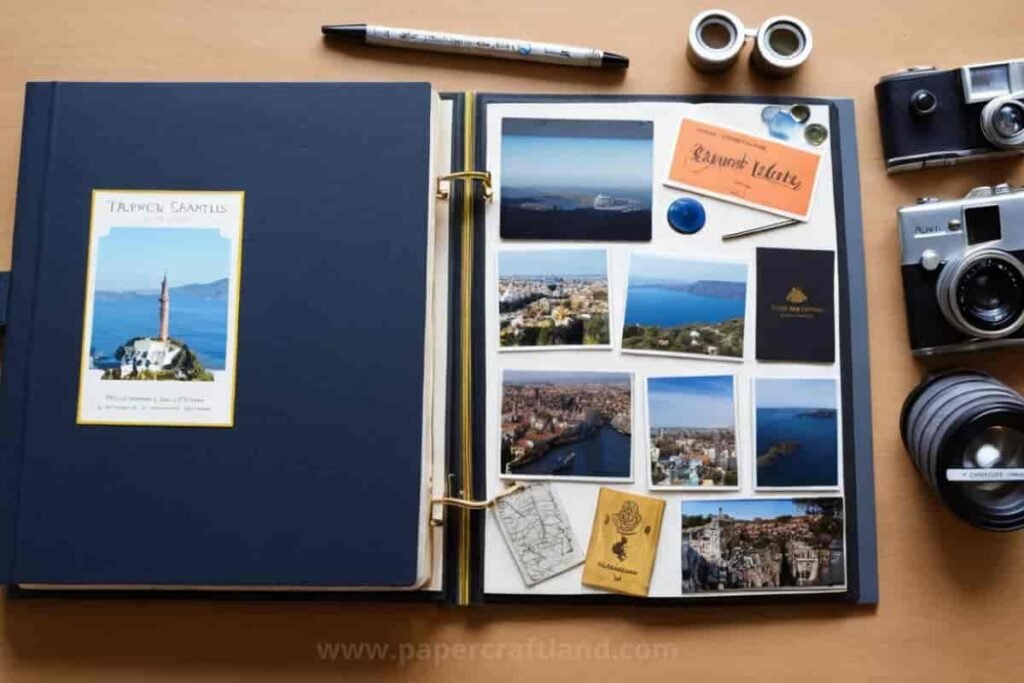
Choosing the Right Scrapbook Album
Your first step in creating a travel scrapbook is choosing an album. Travel scrapbooks come in various sizes, from compact 6×6-inch albums to large 12×12-inch books.
Choose the size based on how many photos and memorabilia you want to include, as well as the overall design aesthetic you’re going for. Hardbound albums are great for long-lasting durability, while ring-bound albums offer flexibility in adding or rearranging pages.
Printed Photos and Memorabilia (tickets, maps, brochures)
One of the best parts of a traditional scrapbook is incorporating physical mementos. Print your favorite photos, but also keep and use items like boarding passes, museum tickets, maps, and restaurant menus. These personal touches help tell the full story of your travels.
Scrapbooking Tools (scissors, glue, embellishments)
For traditional scrapbooks, you’ll need basic tools like scissors, adhesive (double-sided tape or glue sticks), and embellishments such as stickers, stamps, and decorative papers. These tools help you design pages that bring your memories to life.
Journaling Materials (pens, stickers, stamps)
Don’t forget to include space for journaling in your scrapbook! Whether it’s a handwritten reflection about a specific moment or simple captions explaining your photos, journaling adds depth and personal narrative to your pages. Use colorful pens, decorative stickers, or rubber stamps to enhance your written memories.
Essential Tools and Software for a Digital Travel Scrapbooks
Software Options (Photoshop, Canva, etc.)
If you’re opting for a digital travel scrapbook, the first thing you’ll need is the right software. Popular options include Adobe Photoshop for advanced design, Canva for a beginner-friendly interface, or free alternatives like GIMP.
These tools let you create beautifully designed scrapbook pages using layers, textures, and digital embellishments.
Using Digital Templates and Kits
You can streamline the process by using pre-made digital scrapbook kits or templates, which include ready-made backgrounds, frames, and embellishments.
Websites like Etsy, Creative Market, and PixelScrapper offer a wide range of themes, from vintage to modern, allowing you to customize your pages with minimal effort.
Organizing Digital Files (photos, scanned memorabilia)
One of the keys to successful digital scrapbooking is keeping your files organized. Create folders for each trip, and within each folder, categorize your photos, scanned documents (like tickets and brochures), and any digital assets (templates, stickers, fonts). This will make the design process smoother and more enjoyable.
Backing Up Your Digital Travel Scrapbooks
To avoid losing your hard work, always back up your digital scrapbook files to an external hard drive or cloud storage service. This ensures that your digital scrapbook is safe from potential data loss and can be accessed across different devices.
How to Plan and Organize Your Travel Scrapbooks
Choosing a Theme for Your Scrapbook
Before you start cutting or designing, decide on a central theme for your travel scrapbook. Are you going for a chronological account of your trip, or are you focusing on specific experiences (like culinary adventures or nature hikes)? A theme will guide your design choices and help create a cohesive look.
Sorting and Selecting Photos
When it comes to photos, less is often more. Pick your favorite shots that best capture the essence of your trip. Don’t overwhelm the pages with too many images—this can clutter your design and dilute the impact of individual memories.
Arranging Memorabilia and Ephemera
Memorabilia like maps, tickets, and receipts can be arranged around your photos to fill in the details of your journey. Be thoughtful about the placement of these items—they should complement your photos rather than overwhelm them.
Creating a Rough Layout
Sketch a rough layout of how you want your pages to look before gluing or placing digital elements. This allows you to visualize the flow and balance of each page, ensuring that it tells a clear, compelling story.
Creating a Travel Scrapbooks: Step-by-Step Guide
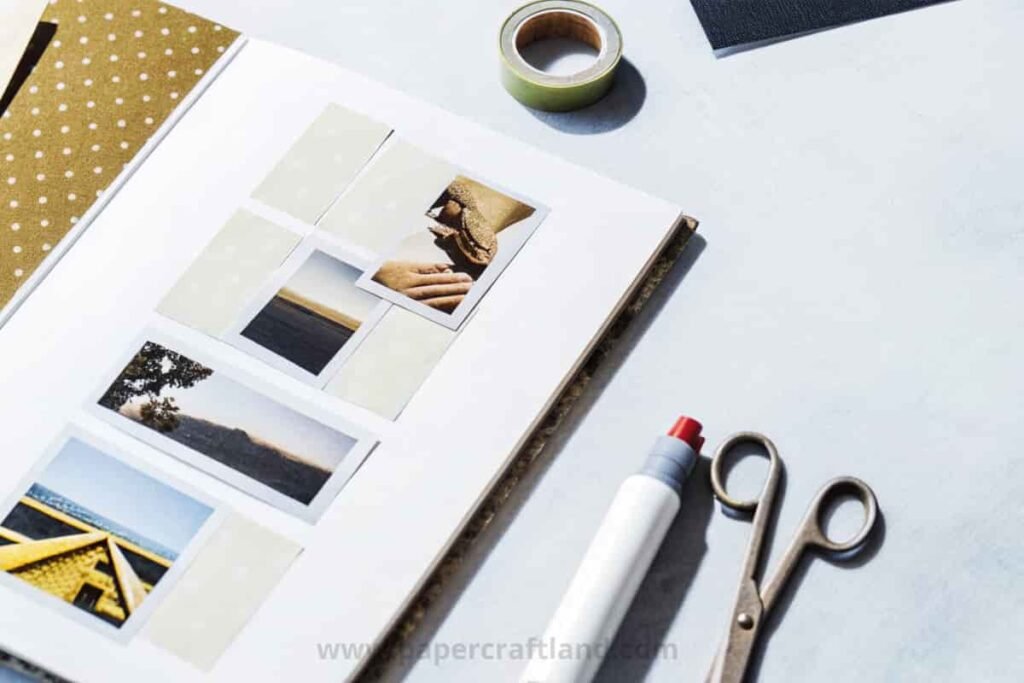
Selecting a Scrapbook Style (minimalist, vintage, eclectic)
Choose a style that reflects both your trip and your personality. A minimalist scrapbook might feature clean lines, soft colors, and a focus on photos, while a vintage scrapbook might include distressed paper, sepia-toned photos, and antique maps.
Eclectic styles let you mix and match elements from different design themes, creating a dynamic and vibrant scrapbook.
Designing Your First Page
Start with the cover or introductory page, which should set the tone for the rest of the scrapbook. This page might include a map of your destination, a favorite photo, or a quote about travel. Keep it simple but impactful.
Incorporating Maps, Tickets, and Travel Ephemera
Incorporating maps from your journey is a great way to add context and geographical interest to your pages. You can also use tickets, postcards, and even restaurant receipts as unique embellishments that showcase the details of your experience.
Adding Journaling and Captions
Journaling is what brings a personal touch to your scrapbook. Write short captions under your photos, or dedicate sections to longer reflections about the places you visited, the people you met, or the lessons you learned along the way.
Tips for Elevating Your Travel Scrapbooks Design
Use of Color to Evoke Emotions
The colors you choose for your scrapbook can evoke specific emotions and set the mood. For example, cool tones like blue and green can reflect the serene beauty of nature, while warm tones like orange and red can convey excitement and energy.
Creative Typography and Fonts
Typography plays a big role in the overall aesthetic of your scrapbook. Experiment with fonts that reflect your destination or trip—handwritten fonts for a personal feel, or bold, modern fonts for a sleek, urban look.
Incorporating Travel-Themed Elements (globes, planes)
To add thematic consistency, include travel-related embellishments such as globes, planes, luggage tags, or compasses. These small elements can tie the pages together and emphasize the travel focus of your scrapbook.
Layering and Texturing for Depth
Layering different elements (photos, paper, stickers) and using textures can give your pages depth and dimension. In digital scrapbooking, this might involve adding drop shadows or using digital overlays that mimic the feel of paper or fabric.
Preserving Travel Memories Through Journaling
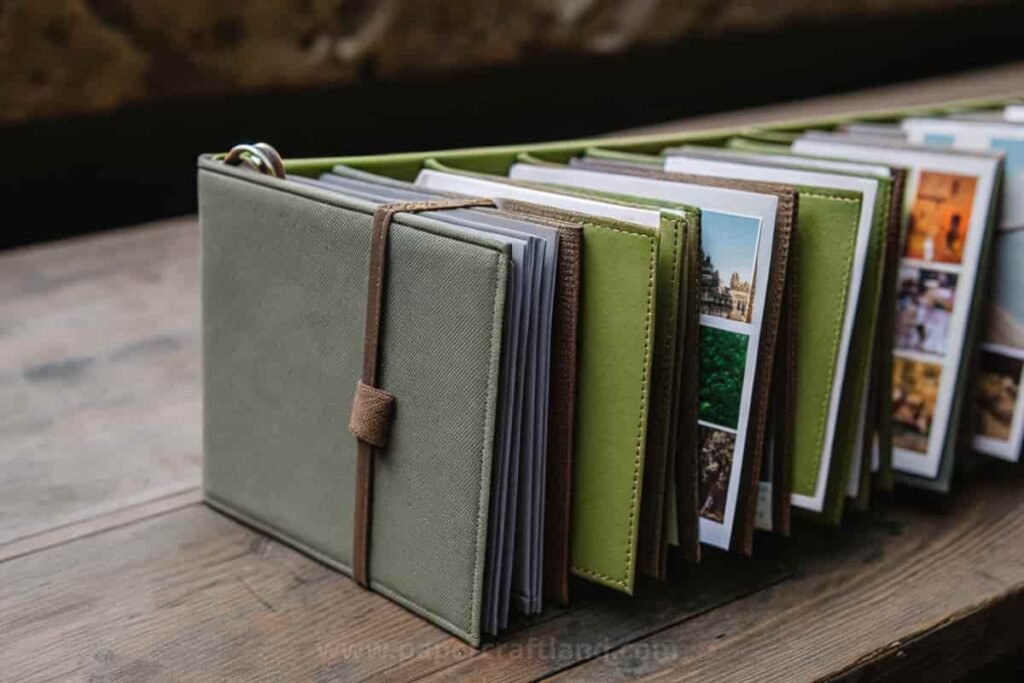
Writing Personal Reflections
Your scrapbook is not just about the visual elements—it’s also a place to reflect on your journey. Write about your favorite moments, the challenges you faced, or the surprises that made the trip unforgettable.
Capturing Sights, Sounds, and Smells
In addition to describing what you saw, try to capture the sights, sounds, and smells of the places you visited. Writing about the scent of street food, the noise of a bustling market, or the feel of a tropical breeze adds depth to your scrapbook, transporting you back to that moment.
Adding Quotes and Stories
Incorporate quotes from local people, snippets of conversations, or even lyrics from a song that was popular during your trip. These small details can enrich your narrative and give a sense of time and place.
Tips for Keeping a Travel Journal During Your Trip
Keep a small notebook or use your phone’s notes app to jot down thoughts throughout your trip. This makes it easier to remember specific details when you’re creating your scrapbook later.
Best Types of Memorabilia to Include in a Travel Scrapbooks
Postcards and Travel Stamps
Postcards are a classic addition to travel scrapbooks, often featuring local art or iconic landmarks. Travel stamps from your destination add an extra level of authenticity and are a great way to highlight your international trips.
Brochures, Maps, and Tickets
Brochures and maps offer context and visuals for the places you visit, while tickets (from museums, events, or public transportation) serve as time stamps for your adventures.
Currency and Small Tokens
Small pieces of local currency or other tokens (like coins or pressed pennies) make for unique keepsakes. Just make sure to keep them secured within your scrapbook to prevent damage or loss.
Photos with Personal Notes
Printing photos and adding handwritten notes about the day, the people you met, or what made the location special adds a personal touch that turns your scrapbook into a true travel diary.
Capturing the Essence of a Destination in Your Scrapbook
Highlighting Cultural Elements (food, music, festivals)
To truly capture the spirit of a destination, include elements that showcase its culture. Add photos of local dishes, ticket stubs from a cultural festival, or written descriptions of the music and dances you experienced.
Creating a Day-by-Day Travel Log
A day-by-day log can be a great way to organize your scrapbook, especially for longer trips. This chronological approach allows you to relive your journey step-by-step and ensures you don’t forget any key moments.
Using Local Colors, Patterns, and Textures
Incorporate local colors and patterns that are associated with the destination. For example, you might use bright reds and yellows for a scrapbook about Spain, or soft blues and greens for a trip to coastal Greece.
Incorporating Souvenirs and Local Craftsmanship
If possible, include small souvenirs or pieces of local craftsmanship, like a pressed flower from a hike or a scrap of fabric from a market. These tactile items bring your scrapbook to life in a way that photos alone cannot.
How to Print and Share Your Travel Scrapbooks
Printing Traditional Scrapbooks
For traditional scrapbooks, print high-quality photos on archival paper to ensure they last for years without fading. Many online services offer custom printing for scrapbook pages, making it easy to add professional quality to your handmade project.
Options for Printing Digital Scrapbooks
If you’re creating a digital scrapbook, services like Blurb, Shutterfly, or Mixbook allow you to print your designs into beautiful, bound books. These photo books are a great way to keep a professional-looking, durable version of your scrapbook.
Sharing on Social Media or Travel Blogs
You can also share your digital scrapbook online. Post individual pages or a slideshow on Instagram, Pinterest, or your travel blog to showcase your adventure to a broader audience.
Creating Custom Travel Photobooks
Instead of creating a traditional scrapbook, some travelers prefer to create custom photo books, which focus primarily on photos but can also include captions, maps, and simple designs. These photo books are a streamlined, modern alternative to traditional scrapbooks.
Ideas for Themed Travel Scrapbooks
City-Specific Scrapbooks
If you visit a city frequently or have multiple trips to the same destination, consider making a city-specific scrapbook. Focus on different neighborhoods, landmarks, and experiences from each visit.
Nature and Adventure Scrapbooks
For nature lovers, an outdoor adventure scrapbook might highlight camping trips, hikes, national park visits, and wildlife encounters. Use natural colors, leaves, or pressed flowers to complement your nature photos.
Family Travel Scrapbooks
A family travel scrapbook is a wonderful way to document special moments with loved ones. Include photos of everyone together, tickets to family-friendly attractions, and written anecdotes from the trip.
Honeymoon and Romantic Getaway Scrapbooks
For couples, a romantic getaway scrapbook (such as a honeymoon) is a way to commemorate special moments. Add notes about your favorite memories, love quotes, and personal reflections on your time together.
Travel Scrapbooking on a Budget
Affordable Scrapbook Albums and Materials
Scrapbooking doesn’t have to break the bank. Look for affordable scrapbook albums at craft stores, or even create your own using a ring binder and blank paper.
DIY Embellishments and Decorations
Create your DIY embellishments using leftover tickets, stamps, or hand-drawn decorations. You can also cut out photos from travel brochures or free postcards.
Free Digital Scrapbooking Resources
For digital scrapbooking, many websites offer free resources, such as templates, backgrounds, and embellishments. Sites like PixelScrapper and Design Bundles provide free materials to help you craft beautiful scrapbook pages without the cost.
Repurposing Travel Ephemera
Don’t overlook the value of everyday items collected during your trip—restaurant napkins, business cards, or even packaging from local snacks can be turned into memorable embellishments for your scrapbook.
Future Trends in Travel Scrapbooking
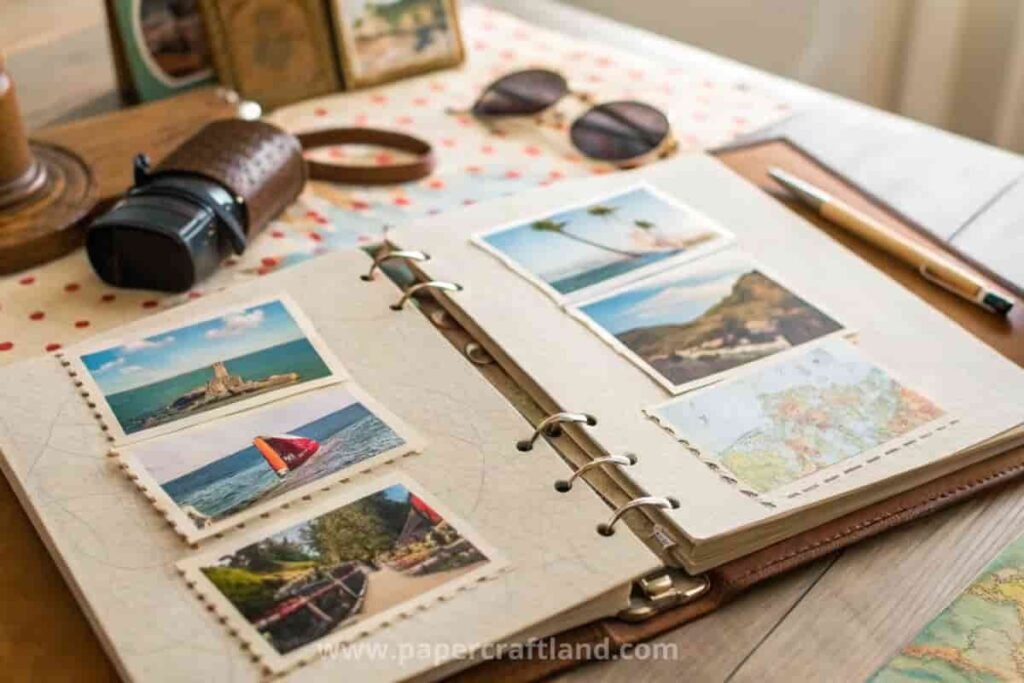
The Use of AR and VR in Scrapbooks
Augmented reality (AR) and virtual reality (VR) could soon play a role in travel scrapbooking. Imagine creating pages where you can scan a code with your phone to see a 360-degree view of a destination or experience a video clip from your trip in real time.
Interactive Scrapbook Pages
Interactive scrapbooks, which include fold-out pages, pockets, and removable items, are gaining popularity. These designs allow for a more tactile, engaging experience when flipping through the album.
Eco-Friendly Scrapbooking Practices
As sustainability becomes more important, travelers are turning to eco-friendly scrapbooking practices, such as using recycled paper, natural embellishments, and minimalist designs that reduce material waste.
Minimalist and Sustainable Travel Journals
A growing trend is the use of minimalist travel journals that focus on reflection and simplicity. These journals use clean designs, and basic materials, and are often combined with mindful travel experiences, like slow travel or eco-tourism.
Conclusion
A travel scrapbook is more than just a collection of photos—it’s a treasure trove of memories, experiences, and emotions from your adventures around the world.
Whether you prefer the hands-on craft of traditional scrapbooking or the convenience of digital design, a travel scrapbook offers a personal and creative way to document your journey.
Start your scrapbook today and create a keepsake that will let you relive your travels for years to come.
FAQs
- What are the best tools for creating a travel scrapbook?
For traditional scrapbooks, you’ll need albums, photos, and crafting supplies, while digital scrapbooks require design software like Photoshop or Canva.
- Can I create a travel scrapbook without photos?
Yes! You can focus on memorabilia like tickets, maps, postcards, and journaling to document your trip.
- How do I preserve fragile travel memorabilia in a scrapbook?
Use archival-quality sleeves or envelopes to protect delicate items, such as tickets or currency, and secure them with acid-free adhesives.
- Are there affordable digital tools for travel scrapbooking?
Canva and GIMP are great free options for digital scrapbooking, offering templates and tools that are easy to use.
- How can I make my travel scrapbook more interactive?
Include fold-out pages, hidden pockets, and interactive elements like pull tabs or envelopes to make your scrapbook more engaging.
- How can I organize my travel scrapbook chronologically?
Divide your scrapbook into sections by day or location, using headings and journaling to keep the sequence clear.
- Can I make a travel scrapbook from past trips?
Absolutely! Gather photos, tickets, and memorabilia from previous trips to create a nostalgic scrapbook that captures past adventures.

